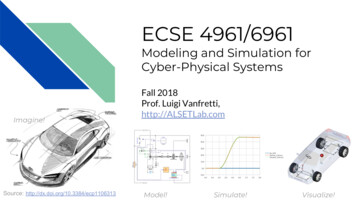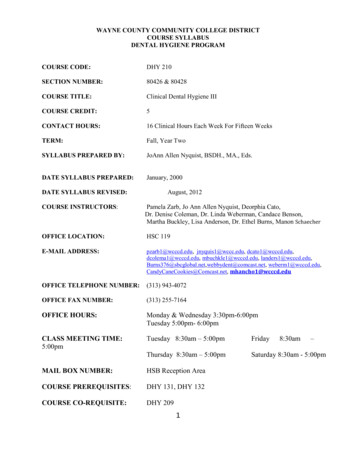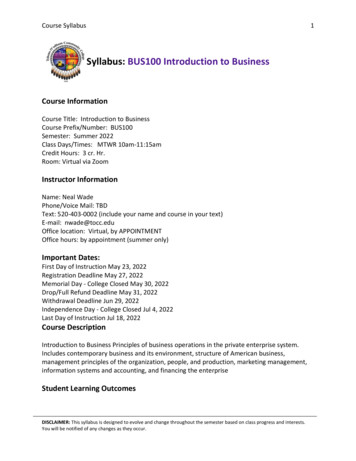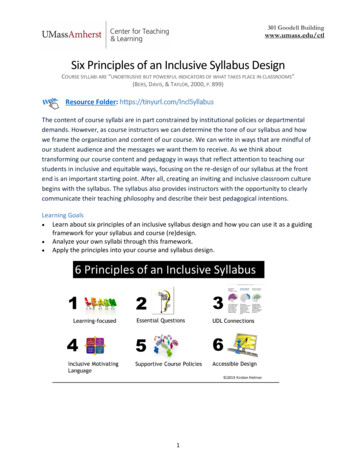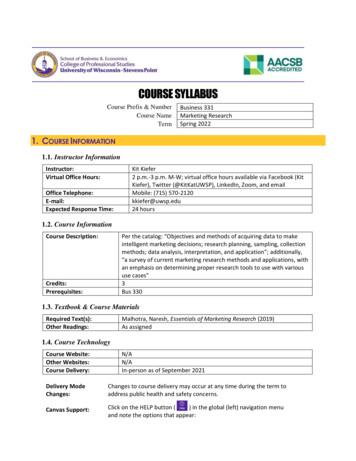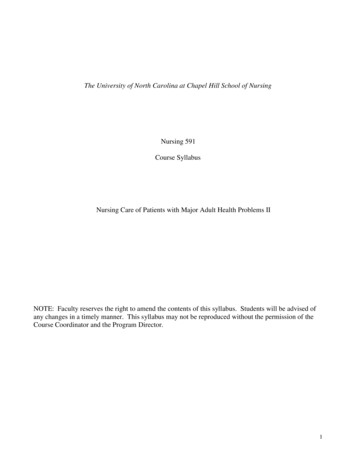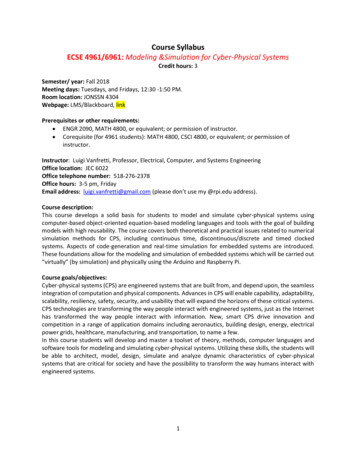
Transcription
Course SyllabusECSE 4961/6961: Modeling &Simulation for Cyber-Physical SystemsCredit hours: 3Semester/ year: Fall 2018Meeting days: Tuesdays, and Fridays, 12:30 -1:50 PM.Room location: JONSSN 4304Webpage: LMS/Blackboard, linkPrerequisites or other requirements: ENGR 2090, MATH 4800, or equivalent; or permission of instructor. Corequisite (for 4961 students): MATH 4800, CSCI 4800, or equivalent; or permission ofinstructor.Instructor: Luigi Vanfretti, Professor, Electrical, Computer, and Systems EngineeringOffice location: JEC 6022Office telephone number: 518-276-2378Office hours: 3-5 pm, FridayEmail address: luigi.vanfretti@gmail.com (please don’t use my @rpi.edu address).Course description:This course develops a solid basis for students to model and simulate cyber-physical systems usingcomputer-based object-oriented equation-based modeling languages and tools with the goal of buildingmodels with high reusability. The course covers both theoretical and practical issues related to numericalsimulation methods for CPS, including continuous time, discontinuous/discrete and timed clockedsystems. Aspects of code-generation and real-time simulation for embedded systems are introduced.These foundations allow for the modeling and simulation of embedded systems which will be carried out“virtually” (by simulation) and physically using the Arduino and Raspberry Pi.Course goals/objectives:Cyber-physical systems (CPS) are engineered systems that are built from, and depend upon, the seamlessintegration of computation and physical components. Advances in CPS will enable capability, adaptability,scalability, resiliency, safety, security, and usability that will expand the horizons of these critical systems.CPS technologies are transforming the way people interact with engineered systems, just as the Internethas transformed the way people interact with information. New, smart CPS drive innovation andcompetition in a range of application domains including aeronautics, building design, energy, electricalpower grids, healthcare, manufacturing, and transportation, to name a few.In this course students will develop and master a toolset of theory, methods, computer languages andsoftware tools for modeling and simulating cyber-physical systems. Utilizing these skills, the students willbe able to architect, model, design, simulate and analyze dynamic characteristics of cyber-physicalsystems that are critical for society and have the possibility to transform the way humans interact withengineered systems.1
Student Learning Outcomes:1. Comprehend the fundamental principles of modeling and simulation of continuous, discrete, hybridand timed-clocked systems that lead to the formulation of cyber-physical system models.2. Comprehend and apply computer-and-equation based object-oriented languages for modeling ofcyber-physical systems using the Modelica language.3. Comprehend and explain methods used for symbolic transformation of computer models, efficiencyissues in numerical solutions and effect of nonlinearities, higher-and-varying index problems,initialization methods, event handling, and other numerical issues related to mathematical solversused for simulation and co-simulation.4. Construct simulation models for cyber-physical systems using the Modelica language in ModelicaEnvironments such as Dymola and OpenModelica.5. Comprehend and explain the concept of real-time simulation, and hardware-in-the-loop simulation.6. Comprehend concepts of embedded systems, and apply solutions for real-time simulation with anembedded system in-the-loop.Additional Learning Outcome for 65114 students / Project:A. Apply learning outcomes 1-4 to a problem specific to your own research or one of the followingpreferential projects in power engineering M&S:oooM&S of power system components for positive sequence simulation in the OpenIPSL library (seelist of potential models herein: https://github.com/OpenIPSL/OpenIPSL/projects )Mixed positive sequence and three-phase models for power electronic-based components (e.g.VSC-HVDC, FACTS, Battery Energy Storage, etc.)Power electronic systems for traction, e.g. automotive applications, aerospace, etc.B. Or, Apply learning outcomes 1-4 to a problem specific to your own research or one of thefollowing preferential projects in multi-domain simulation:oooMulti-domain M&S of power systems and fuel cell energy sources using the Fuel Cell library.Multi-domain M&S of power systems and hydro-power systems using the HydroPower Library.Multi-domain M&S of power systems and Rankine Cycle steam turbines using the ThermalPowerLibrary.C. Or, Apply learning outcomes 5-6 to a problem specific to your own research or one of thefollowing preferential projects in cyber-physical systems simulation:o Interface simulation outputs from the OpenIPSL pseudo-PMU model to TCP using theModelica Device library.o Control design, coding and simulation for the 6-DOF arm robot using the ModelicaArduino library.o Model PMUs using timed clocked sensors with different loop rates using the theModelica Synchronous library.Course Contents / Topics:1. Introduction to M&S for CPS2. Fundamentals Numerical Algorithms: Numerical Integration for Differential-Algebraic Equations3. Developing Equation-Based Object-Oriented System Models using Modelica and the MSL4. Understanding Numerical Problems and Debugging Models5. Building Models and Simulations for Re-use6. Hybrid Modelling: Discontinuous, Sample-Data Systems, Discrete Event Simulation and Timed Clocks7. CPS Modeling and Simulation: Embedded Systems, Model Exchange and Real-Time Simulation8. System of Systems Engineering: Requirements and Specifications with integrated behaviourmodelling2
Course textbooks (required/mandatory): Francois E. Cellier and Ernesto Kofman, “Continuous System Simulation,” Springer-Verlag New York,Inc. Secaucus, NJ, USA, 2006. ISBN:0387261028 P. Fritzson, Principles of Object-Oriented Modeling and Simulation with Modelica 3.3: A CyberPhysical Approach. Wiley-IEEE Press, 2014. ISBN: 978-1-118-85912-4. (Free-of-cost) Michael M. Tiller, Modelica by Example. E-book. On-line: http://book.xogeny.com Dymola, FMI Toolbox and Papyrus-RT User Manuals (Digital version with the software)Required Embedded Platform: Raspberry Pi Arduino UnoIt is possible to find many options online, the following two are just suggestions: Official Arduino Starter Kit: https://store.arduino.cc/usa/arduino-starter-kit Combo including both platforms: rryoddWires/dp/B01MXTWE8AOther Suggested Books and References: P. Fritzson, Introduction to Modeling and Simulation of Technical and Physical Systems withModelica. Wiley-IEEE Press, 2011. ISBN: 978-1-118-01068-6. E. A. Lee and S. A. Seshia, Introduction to Embedded Systems – A Cyber-Physical Systems Approach,LeeSeshia.org, 2011. On-line: http://leeseshia.org/index.html Martin Otter, Modeling, Simulation and Control with Modelica 3.0 and Dymola 7.0. Available ptOtter-2009-01-21.pdf Michael M. Tiller, Introduction to Physical Modeling with Modelica, The Springer International Seriesin Engineering and Computer Science (Book 615), Springer, 2001.Francois E. Cellier, Continuous System Modeling. Springer, 1991.James Nutaro, Building Software for Simulation: Theory, Algorithms, and Applications in C . Wiley2010. Computing Tools: Dymola – licenses to be provided by RPI.OpenModelica – open source software.FMI Toolbox for MATLAB/Simulink – licenses to be provided by RPI.Grading criteria Letter grading: A/A- high competency in concepts and understanding of the methods; B /B/B- goodcompetency; C /C marginal competency. Quantitative assessment: Homework/Computer Labs: 30% total. Tests/Exams: Tests 1 and 2, 40% each.Project: 30%.Homework/Lab Assignments Policy All homework/lab assignments and projects will be graded by the instructor or TA. Credits are given for partially correct answers. Homework submission via LMS/Blackboard, write-up, computer-based models and code used tosolve the problems must be provided in a .zip file.3
oo Be organized! Submissions lacking clear organization will be deducted 10% of the grade.For the project and all assignments, a zip file should be organized and contain the following: Nameing: 2018CPS YourFirstandLastName HomeworkNumber.zip Folder organization: ./report.pdfContains your report in either .pdf or .docx files ./presentation.pdf Contains your presentation when applicable in .pdf or.pptx format ./experiments/contains the simulation result files (.mat) used for eachof your plots in the report. ./sourcecode/Your solution files in .mo and Modelica packages ./other/Other documents, information you wish to includeLate homework submission requires the instructor’s permission and valid justification.Tests Policy Tests will be comprised of a theoretical component, and a practical component.For the practical component, you will be using your own computer, and you must be disconnected fromthe wireless/wired internet connection and all messaging/email or similar applications should not beactive in your computer. Any violation of this policy will result in: a grade of zero when the first violationis detected. If there is a subsequent infraction the student will receive a grade of F for the course.Attendance policyAll students are expected to attend classes unless previously excused.Other Policies Extra credit policy: Challenging yourself in this course and showing your own initiative in thesolution of the homework/lab problems will be highly valued, and rewarded following the policy inthe sequel:o Extra credits for exceptional and creative work in the approach to solve problems usingcomputer-based modeling languages, and computer tools; at the instructors’ discretion.o The instruction is willing to write you a good recommendation letter based on yourindividual work. (I do not provide recommendation letters to students that do not show highlevel of individual achievement).o You can request to balance your grade (in case you did poorly on a Test) Mobile/Electronic Devices: All mobile devices (cell/smart phones, etc.) must be stored securely awayduring lecture and are not be used unless specifically directed otherwise by the instructor. Use of(or ANY interaction with) a mobile device during a test without explicit permission of the instructorwill be interpreted as the illicit transfer of exam data, will be considered an act of cheating and will betreated as such. When working with computer problems in class, you must be disconnected from thewireless/wired internet connection and all messaging/email or similar applications should not beactive in your computer.Academic integrityStudent-teacher relationships are built on trust. For example, students must trust that teachers havemade appropriate decisions about the structure and content of the courses they teach, and teachersmust trust that the assignments that students turn in are their own. Acts that violate this trust4
undermine the educational process. The Rensselaer Handbook of Student Rights and Responsibilitiesand The Graduate Student Supplement define various forms of Academic Dishonesty and you shouldmake yourself familiar with these. In this class, all assignments that are turned in for a grade mustrepresent the student’s own work. In cases where help was received, or teamwork was allowed, anotation on the assignment should indicate your collaboration.Submission of any assignment that is in violation of this policy may result in a penalty of: A grade of zerowill be given when the first violation is detected. If there is a subsequent infraction the student willreceive a grade of F for the course.Violations of academic integrity may also be reported to the appropriate Dean (Dean of Students forundergraduate students or the Dean of Graduate Education for graduate students, respectively).If you have any question concerning this policy before submitting an assignment, please ask forclarification.5
Detailed List of Lectures / Course Contents:Introduction to M&S for CPS:1. Introduction to Model-Based Systems Engineering and Fundamentals of Modeling andSimulation for CPS [Cellier Ch. 1]2. Introduction to the Modelica Languagea. Overview of Dymola and OpenModelica [dym manual L1]b. Building Models in Dymola and OpenModelica [dym manual L2]3. Simulation and Post-Processing with Dymola [dym manual L3]Fundamentals Numerical Algorithms:4. Basic Principles of Numerical Integration [Cellier Ch. 2]5. Differential Algebraic Equations [Cellier Ch. 7]6. Differential Algebraic Equation Solvers [Cellier Ch. 8]Developing Equation-Based Object-Oriented System Models:7. System Models and System-Wide Simulation Configuration [dym manual L4]8. Developing Component Models using the Modelica Language [dym manual L5]9. Equation-Based Modeling and Object-Oriented Modeling [dym manual L6]10. Introduction to the Modelica Standard Library [dym manual L7]a) Icons, blocks and math,b) Electrical systems, magnetics,c) Rotational mechanics, translational mechanics,d) Fluid heat flow, heat transfer,e) Multi-domain modelling11. System Models using the MSL and Introduction to Reactive and Hybrid Systems[dym manual L8]a) State Graphs using the MSLb) Multi-body Dynamics in Mechanical Systems using the MSLc) Fluid Systems using the MSLd) Media in the MSLUnderstanding Numerical Problems and Debugging Models12. Numerical Issues in Dymola - Debugging in Dymola [dym manual L9]13. Integrated Debugging in OpenModelica [martin sjolund]14. Issues in Continuous System Simulation [Bernhard Bachman notes]a. Symbolic Transformationsb. Efficiency Issues and Nonlinearitiesc. Higher Index Problemsd. Initializatione. Other numerical Issues15. Initialization Methods in OpenModelica [Lennart Ochel’s Notes]Building Models and Simulations for Re-use16. Re-usable modelling: model architectures, templates and interfaces [dym manual L10]17. Model Variants and Data Management [dym manual L11]18. Workflow automation and scripting [dym manual L13]19. Integrating models with tools [dym manual L14]Hybrid Modelling: Discontinuous, Sample-Data Systems, Discrete Event Simulation and Timed Clocks20. Hybrid Modeling [dym manual L12]21. Discontinuous Systems [Cellier Ch. 9]22. Discrete Event Simulation [Cellier Ch. 11]23. Issues in Hybrid System Simulation [Bernhard Bachman notes]6
a. Event handlingb. State events vs. time eventsc. Symbolic transformations revisitedd. Ideal components/behaviore. Varying higher index problemsf. Efficiency and Numerical issues24. Timed clocks and the Modelica Synchronous Library [synchronous lib]a. Clocksb. Samplersc. Non-periodic clocksd. Periodic clockse. Cyber-physical modelsCyber-Physical Modeling and Simulation25. Embedded system modelling and simulationa. Why do M&S of Embedded Systems?b. The Arduino Unoc. Modelica Arduino Library26. Interfacing the Physical Systems & Models with the Cyber Worlda. Modelica Device Library and the Modelica Embedded Library27. Code-Generation and Introduction to Real-Time Simulationa. Code-Generation and Controller-in-the-Loop Simulation using the Raspberry Pib. FMI Standard for Model Exchange and Simulation [LIU Notes]c. Introduction to Real-Time Simulation [dym manual L15]d. Real-Time Simulation Methods [Cellier Ch 10]Advanced Topic / Seminar28. System of Systems Engineeringa. Requirements and Specifications Engineeringb. High Level Architectures and Abstracts for Modelingc. UML, SysML and System Engineeringd. Executable UMLe. Papyrus RTf. SAAB’s Fighter Jet Comfort Model7
Course Schedule (to be completed)2018 Fall Semester, JONSSN 4304, Tuesdays/Thursdays, Tuesdays, and Fridays, 12:30 -1:50PM.Session #DatesExams/NotesHW1HW2HW3Test 1Test 2Final / Project8
2 Student Learning Outcomes: 1. Comprehend the fundamental principles of modeling and simulation of continuous, discrete, hybrid and timed-clocked systems that lead to the formulation of cyber-physical system models. 2. Comprehend and apply computer-and-equation based object-oriented languages for modeling of cyber-physical systems using the Modelica language.
